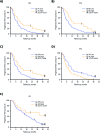Phase I/II trial of vorinostat combined with temozolomide and radiation therapy for newly diagnosed glioblastoma: results of Alliance N0874/ABTC 02
- PMID: 29016887
- PMCID: PMC5909661
- DOI: 10.1093/neuonc/nox161
Phase I/II trial of vorinostat combined with temozolomide and radiation therapy for newly diagnosed glioblastoma: results of Alliance N0874/ABTC 02
Abstract
Background: Vorinostat, a histone deacetylase (HDAC) inhibitor, has shown radiosensitizing properties in preclinical studies. This open-label, single-arm trial evaluated the maximum tolerated dose (MTD; phase I) and efficacy (phase II) of vorinostat combined with standard chemoradiation in newly diagnosed glioblastoma.
Methods: Patients received oral vorinostat (300 or 400 mg/day) on days 1-5 weekly during temozolomide chemoradiation. Following a 4- to 6-week rest, patients received up to 12 cycles of standard adjuvant temozolomide and vorinostat (400 mg/day) on days 1-7 and 15-21 of each 28-day cycle. Association between vorinostat response signatures and progression-free survival (PFS) and overall survival (OS) was assessed based on RNA sequencing of baseline tumor tissue.
Results: Phase I and phase II enrolled 15 and 107 patients, respectively. The combination therapy MTD was vorinostat 300 mg/day and temozolomide 75 mg/m2/day. Dose-limiting toxicities were grade 4 neutropenia and thrombocytopenia and grade 3 aspartate aminotransferase elevation, hyperglycemia, fatigue, and wound dehiscence. The primary efficacy endpoint in the phase II cohort, OS rate at 15 months, was 55.1% (median OS 16.1 mo), and consequently, the study did not meet its efficacy objective. Most common treatment-related grade 3/4 toxicities in the phase II component were lymphopenia (32.7%), thrombocytopenia (28.0%), and neutropenia (21.5%). RNA expression profiling of baseline tumors (N = 76) demonstrated that vorinostat resistance (sig-79) and sensitivity (sig-139) signatures had a reverse and positive association with OS/PFS, respectively.
Conclusions: Vorinostat combined with standard chemoradiation had acceptable tolerability in newly diagnosed glioblastoma. Although the primary efficacy endpoint was not met, vorinostat sensitivity and resistance signatures could facilitate patient selection in future trials.
Figures



Similar articles
-
A randomized phase II study of everolimus in combination with chemoradiation in newly diagnosed glioblastoma: results of NRG Oncology RTOG 0913.Neuro Oncol. 2018 Apr 9;20(5):666-673. doi: 10.1093/neuonc/nox209. Neuro Oncol. 2018. PMID: 29126203 Free PMC article. Clinical Trial.
-
Phase II and pharmacogenomics study of enzastaurin plus temozolomide during and following radiation therapy in patients with newly diagnosed glioblastoma multiforme and gliosarcoma.Neuro Oncol. 2011 Dec;13(12):1331-8. doi: 10.1093/neuonc/nor130. Epub 2011 Sep 6. Neuro Oncol. 2011. PMID: 21896554 Free PMC article. Clinical Trial.
-
Phase II trial of hypofractionated intensity-modulated radiation therapy combined with temozolomide and bevacizumab for patients with newly diagnosed glioblastoma.J Neurooncol. 2015 Mar;122(1):135-43. doi: 10.1007/s11060-014-1691-z. Epub 2014 Dec 19. J Neurooncol. 2015. PMID: 25524817 Clinical Trial.
-
Cilengitide combined with standard treatment for patients with newly diagnosed glioblastoma with methylated MGMT promoter (CENTRIC EORTC 26071-22072 study): a multicentre, randomised, open-label, phase 3 trial.Lancet Oncol. 2014 Sep;15(10):1100-8. doi: 10.1016/S1470-2045(14)70379-1. Epub 2014 Aug 19. Lancet Oncol. 2014. PMID: 25163906 Clinical Trial.
-
Validation of postoperative residual contrast-enhancing tumor volume as an independent prognostic factor for overall survival in newly diagnosed glioblastoma.Neuro Oncol. 2018 Aug 2;20(9):1240-1250. doi: 10.1093/neuonc/noy053. Neuro Oncol. 2018. PMID: 29660006 Free PMC article. Clinical Trial.
Cited by
-
Synergistic Enhancement of Cancer Therapy Using HDAC Inhibitors: Opportunity for Clinical Trials.Front Genet. 2020 Sep 11;11:578011. doi: 10.3389/fgene.2020.578011. eCollection 2020. Front Genet. 2020. PMID: 33024443 Free PMC article. Review.
-
HDAC-an important target for improving tumor radiotherapy resistance.Front Oncol. 2023 Jul 12;13:1193637. doi: 10.3389/fonc.2023.1193637. eCollection 2023. Front Oncol. 2023. PMID: 37503317 Free PMC article. Review.
-
The Impact of Epigenetic Modifications on Adaptive Resistance Evolution in Glioblastoma.Int J Mol Sci. 2021 Aug 3;22(15):8324. doi: 10.3390/ijms22158324. Int J Mol Sci. 2021. PMID: 34361090 Free PMC article. Review.
-
Therapeutic Targeting of Hypoxia-Inducible Factors in Cancer.Int J Mol Sci. 2024 Feb 8;25(4):2060. doi: 10.3390/ijms25042060. Int J Mol Sci. 2024. PMID: 38396737 Free PMC article. Review.
-
Epigenetic Control of Gene Expression in the Normal and Malignant Human Prostate: A Rapid Response Which Promotes Therapeutic Resistance.Int J Mol Sci. 2019 May 17;20(10):2437. doi: 10.3390/ijms20102437. Int J Mol Sci. 2019. PMID: 31108832 Free PMC article. Review.
References
-
- Chinot OL, Wick W, Mason W et al. . Bevacizumab plus radiotherapy-temozolomide for newly diagnosed glioblastoma. N Engl J Med. 2014;370(8):709–722. - PubMed
Publication types
MeSH terms
Substances
Grants and funding
LinkOut - more resources
Full Text Sources
Other Literature Sources
Medical
Miscellaneous

